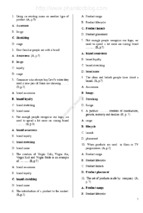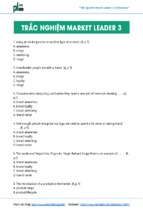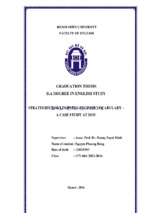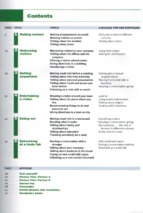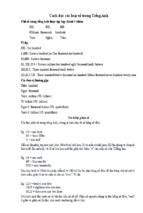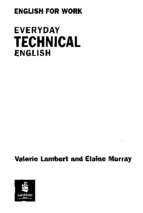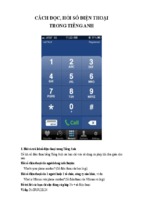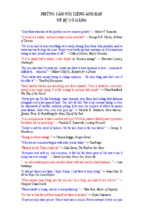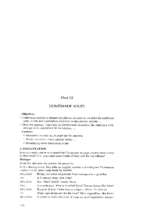Pearson Education Limited,
E:dinburgh Gate. I-Iarlow
Essex CM20 2JE, England
and Associated Companies throughout the world.
www.longman-elt.com
© Mark Ellis, Nina O'Oriscoll and Adrian Pilbeam 1987
Published jointly by Studentlitteratur AB, Lund, Sweden
and Longman Group UK Limited, London, England.
All rights reserved. No part of this publication may be
reproduced, stored in a retrieval system, or transmitted in
any form or by any means, electronic, mechanical,
photocopying, recording or otherwise, without the prior
written permission of the Publishers.
First published 1987
~Irst published in colour 1992
Ninth impression 2000
ISBN 0 582 09306 6
Set in.9/11 pt Linotron 202 Helvetica
Printed in China
SWTC/09
We are grateful to the following for their permission to
reproduce copyright photographs:
British Telecommunications PLC for page 13.jTeleFocus for
page 34; The Image Bank for page 50 ,/Kaz Mori for page 6
and/Steve Niedort for page 37; Tony Stone Worldwide for
pages 19, 30 and 43.
Cover Photograph by The Image Bank/Jay Freis.
Contents
Introduction
4
Getting through, introducing yourself
and taking messages
6
Recorded messages
13
Fixing appointments
19
Discussing information;
changing appointments
30
Making a booking; repeating and
clarifying information
37
Checking and discussing information
43
Participating in a telephone conference
50
Key
Glossary
59
80
INTRODUCTION TO THE LEARNER
Telephoning is part of the Longman Business English
Skills series. It presents and practises the language used
in business situations where the conversation is carried out
by telephone. The conversations in each unit take place in
familiar situations in different types of company and in
different types of offices within those companies. It allows
you, as the learner, to both hear and practise the kind of
language common to many situations.
Objectives
The book assumes from the start that you have at least
a basic general knowledge of English , and that your aim is
to improve in an area of more specialized usage. The book
has a double function: to allow you to hear and understand
fluent conversations and to practise some of the most
useful language yourself.
The dialogues
First you are presented with a dialogue, in Part 1 of each
unit. You should listen to this as many times as you like
to gain a general understanding, but you should not, at this
point, read the tapescript. To help you understand the
dialogue better, turn first to the Listening for information
section which contains questions intended to guide you.
Next, turn to the Focus on Language section , whose
purpose is to help you focus on particular language points.
In both cases, the objective is to improve your
understanding.
Pronunciation
The Pronunciation work is designed to improve your
spoken English.
Note the following three points.
contractions - this is when certain words , often auxiliary
verbs, are reduced to a single consonant. In every repetition
practice in this book , this will be signalled to you by a line
underneath the contraction.
liaison - this means the linking of two words by joining the
last sound of one , when it is a consonant, to the first sound
of the other, when it is a vowel. The two together make a new
syllable. This is signalled to you by a half circle underneath
the parts of the words to be joined.
stress - some words in a sentence are more important
than others: and within those words , there is always one
syllable which carries stress, or the main accent. This is
signalled to you by a circle showing you which syllable to
pronounce more strongly.
4
Words which are important to the theme of a unit, and
which might also be new to you , can be found in the glossary
at the end of each unit. There is also a general glossary of
useful telephoning expressions on page 80.
This book is designed above all for the student studying
alone without the aid of a teacher, and this becomes
especially apparent in Part 2 of each unit, where the objective
is to give you extensive practice at speaking through a
series of Activities . The objective of many of these
activities is to simulate a dialogue. Because you will very
often be working alone , rather than with a teacher who could
provide a response , you will find the other half of the
conversation on the cassette . You should prepare
yourself to answer or to ask questions from the information
in your book and then you should try to 'hold a conversation'
with the cassette , speaking in the spaces provided . If you
are working alone and without the use of a language
laboratory, you can add to the value of this activity by using
a second cassette recorder and a blank tape and recording
yourself doing each exercise. You can then compare your
versions with the ones on the cassette .
ne key
The key contains the tapescripts and answers . When you
have finished Part 1 of each unit, you can read the script
while liste.nirig to the dialogue. The answers to the Practices
and Activities follow the tapescripts . Remember that the
answers to the Activities are suggested student
responses. Yours could be different. However, the versions
in the answer section can be used as models.
Approach
The cassette recorder gives you great flexibility . In
particular, you are able to replay a dialogue or part of a
dialogue as many times as you wish .
Do not be afraid to refer to the scripts to help you , if you
find the dialogue too difficult. You may want to do this quite
a lot, especially in the early stages .
If you take this approach , and do not use the book and
cassette as a testing device, you will find that as you
progress through the units your understanding and ability to
respond correctly will improve dramatically.
1
Getting through, introducing yourself
and taking messages
Getting through, introducing yourself and taking messages
UT 1
The object of this part of the unit is to present ways of
getting through to the person you wish to speak to, and of
introducing yourself.
,round
You are going to hear Steve Newman , manager of a small
company speaking to the switchboard operator in a large
office block in London which is shared by many companies .
He then speaks to an administrative assistant in a company
which provides service offices.
Steve Newman's company is at present based in a
London suburb , but would like to move to central London
in order to be better placed to take on more business.
Listen to the conversation and use the memo to record
the relevant details you think would be noted down by the
administrative assistant at Victoria Holdings.
Victoria Holdings Ltd
Memo
Date _ _ _ _ _ _ _ _ _ _ _ _ __
To _ _ _ _ _ _ _ __ _ _ _ _ ___
- - -_ _ _ _ _ _ _ _ _ _ _ called
Time _______________
Caller's number is
Message
From ___________
~
1
1
Getting through, introducing yourself and taking messages
le l
Focus on
Language
Listen to the conversation again and write down phrases
that correspond to the list of purposes below. Some have
been done as examples.
PHRASE
Conversation
between the
switchboard
operator and
Steve Newman.
Giving the reason
for the call.
2 ________________________________________
Offering to get
the right person .
3 They're the people that deal with it.
Saying they are
in charge , or
responsible for it.
4 _____________________________________
5 ____________________________________
6 _______________________________________
Conversation
between Steve
Newman and
Charles Hughes
the administrative
assistant.
Asking the caller
if he will wait.
The caller is
showing he is
prepared to wait.
The operator is
explaining the
connection has
been made.
7 Victoria Holdings .. .
Answering by
giving the name.
8 Could I have the name of the company, please?
This is a
polite way of
asking for
information .
9 ____________________________________
10 Maylhaveyourname?
8
PURPOSE
1 I'd like to speak to someone about ...
The assistant
wants to know how
to write the name.
This is a
polite way of
asking the caller's
name.
11 ____________________________________
The assistant
promises to give
the information
to the right
person .
12 _____________________________________
Asking if the
person can be
contacted later.
Getting through, introducing yourself and taking messages
13 I'll get Michael Green to call you back . ..
The assistant
promises action .
14 Thank you for your call.
Closing the
conversation.
Check your
answers in the key.
PRACTICE 1
1
In the following conversation, choose the most suitable
response.
A Hello, is that accounts?
B Yes, it is.!1 am. (1)
A I'd like to speak to Sara Adams, please.
B I amiThis is (2) Sara Adams.
A Hello, my name is Peter Brown, from Pacesetters.
I calliI'm calling (3) about a bill we sent you .
B Oh, you should speak to my colleague, Roger Simons. I'll
put you through to his extension.
A Thank you.
B The line's busy. Are you holding?I Will you hold? (4)
A Yes, I am.!1 will. (5)
B I'm afraid the line is still busy. WouldlCould (6) you give
me your number and 111'11 (7) ask him to call you
againlback? (8)
A Yes, certainly. It's 56-89839.
B Thank you . Goodbye.
Check your
answers in the key.
A Goodbye.
Language
Summary
Will
This section draws attention to some of the language used
in the dialogue.
EXAMPLE
COMMENT
I'll put you through.
Will is used in
an immediate
reaction , in
order to offer or
promise to do
something for the
caller. When
speaking we
usually use the
contraction
('/~ , although
not at the
beginning of a
question .
I'll hold on.
I'll pass this information on.
I'll get him to do that.
Will you hold?
Who'll be able to help you?
9
1
Getting through, introducing yourself and taking messages
Get
Prepositions
I'll get him to do thatl to ring you back.
Get is a
commonly used
verb in English :
here, it means
I'll ask him
to . . .
/'II' put you through to Victoria Holdings.
Notice the
prepositions are
part of the verb.
Can he ring you back?
I'm interested in renting office space.
la l
Telephone
numbers
01-449-8927
PRACTICE 2
Pronunciation
Notice that we
usually say
" double four".
Listen to the cassette and repeat the phrases, without the
aid of the book. Then listen and repeat with the book , or after
having looked at it.
PHRASE
0 0 0
please.
1 I'd like to speak to someone about renting office space,
~
'-.J
o
2 Will you hold?
o
0
3 I'll hold on.
-
\.J
4 Can I hJ'Jp you?
5 I'm 'iltterested in renting gffice space.
-
0\.J...J
0
6 Could you spell that name for me, please?
o
0
7 May I have your name?
0
\J
8 and your number?
o 0 00
9 01-449-8927.
"10
"/1 pa~s
-
this information gn .
OV
0
11 Can he ring you back?
'-'
00.
12 Yes, certainly.
13 I'll g~t Michael
-0
Gre~n to call you ba~k.
0
14 Thank you for your call.
10
Getting through, introducing yourself and taking messages
PART 2
In this part you are going to practise speaking to a
switchboard operator and introducing yourself.
In all four Activities you will hear on ly one side of the
conversation. You must act out the other side, by speaking
aloud when it is your turn .
Im l
ACTIVITY 1
You call a computer company called Zanek Computers.
You want to know about their Triple X microcomputers.
Speak to the switchboard operator. Try to use some of the
language you 've already heard and studied .
11£811 ACTIVITY 2
The switchboard operator at Zanek Computers has put
you through to the Sales Department. When the Sales
Assistant asks you questions, you should use the following
information in your answers. You are a potential customer.
Your name: H~ £~
Your company: p(j~HeAt rt CMtf~
Your number.. q27- 565"(
You want 1Ylple- X' MAC/Oinformation ~~ #Y ~Se
about: tnt o{ffCL
W\..
Now play the cassette and reply appropriately, using the
information above.
Compare your
version with the
model version in
the key . It is on
the cassette .
1
1
Getting through, introducing yourself and taking messages
Iml
ACTIVITY 3
You are the secretary in the accounts department of a
large company and are responsible for receiving calls and
putting the caller through to the right person. Here, a caller
wishes to speak .to your colleague, Judith Roberts. At first,
Judith's number is engaged, but it rings the second time.
You are the secretary: speak to the caller.
Iml
ACTIVITY 4
You receive a call about your company's range of video
cassette recorders . You are responsible for sales of the
Standard recorder, and your colleague , Geoffrey White, is
responsible for the Deluxe Model. So when you receive the
call, deal with the enquiry:
•
give the name of your department (Sales)
•
find out if the caller wants Standard or Deluxe
•
make a note of the caller's name, the name of their
company and the telephone number
•
tell the caller you'll give the information to Geoffrey White
Glossary
switchboard
operator
service
offices
deal with
the person who works on the switchboard, which is the
central point for all calls coming into the company
offices where all the furniture, telephone and services
such as photocopying and typing, are provided
to be in charge of, or responsible for, something
put through to . someone, usually the operator, connects or passes you
to someone else
hold, hold on
pass on
12
wait, don't go away
to give or transmit information to the right person
Compare your
version with the
model version in
the key . It is on
the cassette.
Compare your
version with the
model version in
the key. It is on
the cassette.
Recorded
messages
2 Recorded messages
PART 1
This part of the unit will present examples of recorded
messages on answerphones and will give practice in
leaving your own messages.
Background
Lionel Webster works as a buyer in a busy import/export
office in London,He often receives phone calls from all over
the world from brokers with offers of cargo for sale,
You are going to hear a broker leaving a message on
Webster's answerphone concerning the arrival of the ship
carrying his cargo .
Iml Listening
Note the following details while you are listening to the
for information
message for the first time.
Name of caller:
CaltbacK number:
Estimated date of delivery:
Arrival port:
Name of vessel:
Check your
answers 'in the key.
IWI
Focus on
Language
Now listen to the cassette again and answer the following
questions.
1
What phrases does Webster use to:
a
b
c
d
introduce himself?
explain his absence?
give instructions to the caller?
thank the caller?
2 Webster explains he will return soon ; what words does he
use instead of return and soon?
3 How does Bonner introduce himself?
4 What are the two phrases he uses when he spells words?
5 What phrase does he use to give the reason for his call?
6
When exactly will he call back?
7 Does he want Lionel Webster to do anything?
14
Check your
answers in the key.
2
Recorded messages
Language
Summary
Will
This section draws attention to some of the language used
in the dialogue.
EXAMPLE
COMMENT
The vessel will be the Atheco.
Helmut Bonner
uses will, to
show that the
information is
definite.
I'll spell that.
He offers or
promises to do
something very
specific.
/'11 call back with the exact time of arrival.
From
About
la l
PRACTICE 1
I'm calling from Hamburg.
He is giving
information about
where .
I'm calling about our next delivery to you.
. . . and why he is
calling.
Pronunciation
Listen to the next part of the cassette and repeat the
phrases without the aid of the book. Then listen and repeat
with the book, or after having looked at it.
PHRASE
1
o
NOTES
0
This is Lionel Webster speaking.
Notice the name is
said more slowly,
and with more
emphasis, than
the rest of the
phrase.
\..!
o
0
0
2 I'm notV in the'-Joffice\,,/at the moment . . .
o
Notice how his
tone rises at the
end of the last
word .
0
3 butLexpect to be back shortly.
o
0
0
Notice how his
tone drops at the
end of the last
word .
0
4 Please leave lour name, number anqy. message,,9f no
o .
.
more than three mmutes, when you hear the sIgnal.
5
a
0
Thank you for your call.
Notice the pauses
after name,
number and
minutes.
15
2
Recorded messages
IH I
PRACTICE 2
Using the following information, prepare a message as if
for an answerphone. Try to use some of the language Lionel
Webster used .
YOUR NAME:
REASON FOR YOUR
ABSENCE:
EXPECTED TIME
OF RETURN:
INSTRUCTIONS
TO THE CALLER:
Compare your
version with the
model version in
the key. It is on
the cassette .
IE I
PRACTICE 3
Ca.t \
b~ I~ t~e
o..f+eY'l''ID 011\
l.eo..ve ~ J \o\.\AwJ::Ie.v
ou-.d. 0... jN\.ess~e .
ov
Pronunciation
As with Practice 1, listen and repeat without reading, then
open your book and do it again.
NOTES
PHRASE
o
0
0
0
0
Helmut Bonner here. That's B.o.N.N.E.R.
o
00 0
When saying
telephone numbers,
people often say
, 'double-eight"
rather
than " eight-eight" .
2 My number is 880-51-01 .
o
0
3 I'm calling about our next delivery to you.
-
4
s
1&
0
v
Compare this with
the way Lionel
introduces himself
- it's quicker and
more informal.
0
0
The vessel will be the " Atheco " - I'll spell that.
o
0;!]! call back within the next two days.
Recorded messages
le l
PART 2
This part of the unit gives you further practice in
understanding and leaving messages.
ACTIVITY 1
a
2
Listen to the recorded information concerning an
international mining congress. While you are listening ,
note the main details.
Organizer:
5pansar:
Title af [angress:
PlaEe:
Date:
Address far further
information:
Check your
answers in the key.
b
Having decided to attend the Congress , phone your
colleague in Buenos Aires. Prepare the following
message for her answerphone. (You could try recording
it on a blank cassette or write it.)
Your name
Place of departure:
Date of departure :
Flight number:
50cwbev
AA 311
Time of departure:
Compare your
version with the
model version in
the key . It is on
the cassette.
iV\adVld
20 . oS~
Time / Date of arrival Of) OS~
in Buenos Aires :
fo OcfDbev
17
2
Recorded messages
le l
ACTIVITY 2
Listen to this recording on a travel agent's phone . It gives
updated information on fl ights an airline company has to
offer to the USA over the next few days. Make a note of the
details.
Check your
answers in the key .
ACTIVITY 3
Prepare a message about yourself, either at home or in
the office .
You should include the following language :
This is . . .
. .. out at the moment.
I'll be back . . .
Please leave . . .
/'JJ call you . . .
Glossary
broker
cargo
vessel
delivery
freight
take off
18
someone who does business, especially buying , for other
people
a specific amount of goods or merchandise
usually, a ship
taking goods to the door of the buyer
any goods, or merchandise being transported
when a plane leaves the ground : the opposite is to land
Compare your
version with the
one given fo r
Practice 2.
3
Fixing
appointments
3
Fixing appointments
PART 1
The objective of this unit is to present language commonly
used on the phone when arranging meetings and fixing
appointments.
Background
You will first hear a conversation between Lisa Alexander,
the manager of a small company Wool Touch, and her bank
manager, Mr Sanchez. Wool Touch is a young company
specializing in woollen and woven products. Lisa Alexander
is interested in investing in new equipment, for which she
is hoping for financial help from her bank, the General
Union .
i§ i
Listening
for information
Before you listen, read the following message. It was
addressed to the credit manager of General Union Bank,
Dominic Sanchez, by his secretary.
===::::.J'/ GENERAL UNION BANK PLC IL.::I ====
To: __~M~y~S~a~h~C~~~=-_____________
------'<::L.:.LIoIS~p.,~A~I~ol.Lxa~~do
- Xem thêm -

